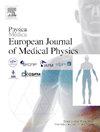利用深度学习改进灌注磁共振图像的参数提取:述评
IF 3.3
3区 医学
Q1 RADIOLOGY, NUCLEAR MEDICINE & MEDICAL IMAGING
Physica Medica-European Journal of Medical Physics
Pub Date : 2025-04-11
DOI:10.1016/j.ejmp.2025.104978
引用次数: 0
摘要
灌注磁共振成像(MRI)是一种评估组织微循环和灌注动力学的非侵入性技术。各种灌注MRI技术,如动态对比增强(DCE),动态敏感性对比(DSC),动脉自旋标记(ASL)和体素内非相干运动(IVIM)提供了对生理和病理过程的关键见解。然而,传统的灌注参数定量方法耗时长,往往容易变异性,并受到噪声和复杂组织动力学的限制。人工智能(AI)的最新进展,特别是深度学习(DL),为这些挑战提供了潜在的解决方案。深度学习算法可以有效地处理大型数据集,提供更快、更准确的参数提取,同时减少了主观性。本文综述了灌注MRI中基于dl的最新技术,考虑了DCE、DSC、ASL和IVIM的获取,重点讨论了它们的优势、挑战和潜在的临床应用。主要发现:与传统方法相比,sdl驱动的方法有望显著改进,解决了噪声、人工干预和观察者间可变性等局限性。深度学习技术,如卷积神经网络(cnn)、循环神经网络(rnn)和生成对抗网络(gan)在处理空间和时间数据、提高图像质量和促进精确的参数提取方面特别有价值。结论这些创新可以彻底改变诊断准确性和治疗计划,将DL与传统成像方法相结合,为灌注MRI提供了新的前沿。随着对精确、高效成像需求的增长,DL在灌注MRI中的作用可以显著改善临床结果,使个性化治疗成为更现实的目标。本文章由计算机程序翻译,如有差异,请以英文原文为准。
Leveraging deep learning for improving parameter extraction from perfusion MR images: A narrative review
Background
Perfusion magnetic resonance imaging (MRI) is a non-invasive technique essential for assessing tissue microcirculation and perfusion dynamics. Various perfusion MRI techniques like Dynamic Contrast-Enhanced (DCE), Dynamic Susceptibility Contrast (DSC), Arterial Spin Labeling (ASL), and Intravoxel Incoherent Motion (IVIM) provide critical insights into physiological and pathological processes. However, traditional methods for quantifying perfusion parameters are time-consuming, often prone to variability, and limited by noise and complex tissue dynamics.
Recent advancements in artificial intelligence (AI), particularly in deep learning (DL), offer potential solutions to these challenges. DL algorithms can process large datasets efficiently, providing faster, more accurate parameter extraction with reduced subjectivity.
Aim
This paper reviews the state-of-the-art DL-based techniques applied to perfusion MRI, considering DCE, DSC, ASL and IVIM acquisitions, focusing on their advantages, challenges, and potential clinical applications.
Main findings
DL-driven methods promise significant improvements over conventional approaches, addressing limitations like noise, manual intervention, and inter-observer variability. Deep learning techniques such as convolutional neural networks (CNNs), recurrent neural networks (RNNs), and generative adversarial networks (GANs) are particularly valuable in handling spatial and temporal data, enhancing image quality, and facilitating precise parameter extraction.
Conclusions
These innovations could revolutionize diagnostic accuracy and treatment planning, offering a new frontier in perfusion MRI by integrating DL with traditional imaging methods. As the demand for precise, efficient imaging grows, DL’s role in perfusion MRI could significantly improve clinical outcomes, making personalized treatment a more realistic goal.
求助全文
通过发布文献求助,成功后即可免费获取论文全文。
去求助
来源期刊
CiteScore
6.80
自引率
14.70%
发文量
493
审稿时长
78 days
期刊介绍:
Physica Medica, European Journal of Medical Physics, publishing with Elsevier from 2007, provides an international forum for research and reviews on the following main topics:
Medical Imaging
Radiation Therapy
Radiation Protection
Measuring Systems and Signal Processing
Education and training in Medical Physics
Professional issues in Medical Physics.

 求助内容:
求助内容: 应助结果提醒方式:
应助结果提醒方式:


